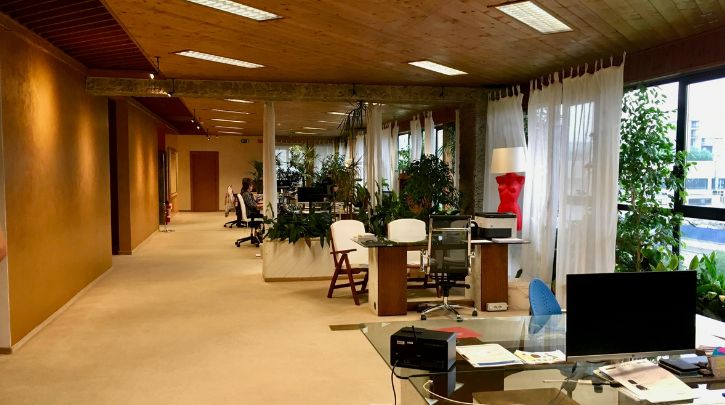- Coworking News
- Coworking Resources
Price. Package. Profit. A Coworking Playbook to Lift Margin

Balancing affordability with long-term profitability is a big challenge in coworking space operations, especially when margins are tight. Turning a profit requires getting comfortable with your numbers; that’s where a smart pricing strategy comes in, laying the foundations for sustainable coworking profitability.
Not sure what a smart pricing strategy looks like? This comprehensive guide covers how to set coworking rates to increase workspace revenue, lower your overheads, and help you operate your coworking business with confidence.
1. Pricing strategy
Before opening your coworking space doors, be totally clear on your coworking profitability by undertaking the following steps.
Step 1: Benchmark your market and competitors
Making smart, low-risk, and profitable business decisions requires conducting thorough market research and analysing coworking spaces in your town or city first.
Look at competitors’ rates to help set your own coworking rates, ensuring you’re not undercharging (and missing out on potential revenue) or overcharging (and driving away prospective members). Don’t hesitate to book tours of other spaces; coworking is a friendly industry, after all.
Applying a wider lens to your market research will help gather inspiration for additional upselling opportunities. Join coworking organisations and attend industry events, such as those organised by the European or London Coworking Assembly, to connect with a wider, more global network.
Step 2: Calculate your costs and break-even point
Once you’ve sketched an idea of your coworking offering, gather an understanding of all the outgoings you’ll spend on your space. This covers capital expenses during the fit-out process, while monthly costs include: utilities, building rents, taxes, staff costs, and supplier costs (technology subscriptions, marketing software, and regular procurement costs). Saving a buffer for repairs and additional maintenance costs is highly recommended.
A break-even point is the moment when your total revenue equals your total costs. From learning this and analysing your market, you can work out your coworking space pricing and estimate how much each of your income streams needs to cover costs and move into profit.

Step 3: Choose your membership models (hot desks, dedicated, private offices)
Offering a variety of coworking membership plans is key to attracting a broad mix of people while keeping your business financially resilient. By creating plans that suit different budgets, working styles, and levels of commitment, you open your doors to a diverse community, and spread risk across multiple income streams.
Common coworking membership plans include
Hot desks. When coworkers occupy a desk for a few hours to a day, without taking ownership of that particular workstation. Hot desks are the cheapest entry to coworking, charged month by month, where you can have more members than workstations in your space.
Dedicated desks: For your more permanent coworking members, dedicated desks offer coworkers exclusive use of a desk, charged at a premium at a fixed monthly rate.
Private offices. One of the most profitable coworking services, private offices are fully enclosed, lockable rooms separate to open-plan coworking areas. Private offices are priced at a much higher rate that’s typically based on the number of workstations in the office.
Make sure your hot desk memberships are distinctly separate from dedicated desks. Lack of perceived value for dedicated desk memberships can cause members to downgrade.
This can happen when:
- The open-plan coworking area is a mix of hot desks and dedicated desks, without any clear benefit for upgrading. Instead, separate zones, offering desks to dedicated members exclusively, while keeping hot deskers to more casual areas, like a cafe environment or shared tables.
If a five-day-a-week hot desk membership is priced only slightly lower than a dedicated desk, members may question its value. Try offering hot desks under day passes and bundles instead, incentivising hot deskers to upgrade and become more permanent community members under dedicated desk membership. - In coworking, a common behaviour pattern is when hot desk members stay in the workspace beyond official opening times. Restricting hot desking to certain times, such as between 8am-8pm, and granting dedicated desk members 24/7 access, creates a clear distinction between the two membership types.
- It’s confusing when hot deskers share the same benefits as dedicated desk members. Consider only giving the latter credits for amenity use, access to more spaces, and locker solutions, providing clear incentives to upgrade.
Experiment, observe the market, listen to your customers and leads and make the best decisions for your business”.

Mark Navarro
Coworking Consultant, Speaker and Writer
2. Package. Exploring add-ons and adjustments
Following the pandemic, the coworking industry began charging for additional services to recoup losses. Today, with flexible workspaces firmly established as a preferred workplace choice, generating income from amenities has become a standard practice to increase workspace revenue.
Additional revenue stream ideas
Day passes
Offering ad-hoc coworking day passes, either single passes or bundles, ensures you’re not just relying on your members, helping you make additional income, and bringing in new customers.
Meeting room hire
Meeting rooms remain popular amongst coworkers worldwide. But don’t be too generous with member access. First-party data from Nexudus found that UK flexible workspaces earned a mean 66% higher price per meeting room booking from external customers than members.
Virtual office memberships
Have you considered offering virtual services?
Not everyone requires a physical office space, but most microbusinesses – or larger ones that operate 100% remotely – can benefit from a virtual office. At its most basic level a virtual office provides companies with a business postal address.
You could also consider offering other services as part of your virtual membership package, such as an envelope opening and scanning, phone answering/voicemail, and discounted access to meeting rooms at your physical space.
Event space rentals
Likewise, making event spaces available for external customers increases workspace revenue. Some city folk book coworking event spaces for birthday parties and family celebrations, so consider renting beyond the 9 to 5 to maximise profit and meet demand.
Partnerships
Coworking and education partnerships are becoming increasingly popular. Coworking operators are starting to collaborate with universities, for instance. Equally, local businesses may also look for space to run sessions, like yoga teachers and therapists.
Concessions
Why purchase a fancy coffee machine when you can work with a growing coffee brand? Welcoming concessions into your workspace, such as having a small coffee shop in your common area, activates the space and creates a meeting point for your community. Charging rent brings in additional income, and you’re supporting another growing business in the process.
Printing
A valuable way of charging more from your resources, capitalising on the fact that fewer people own a printer at home.
Parking spaces
Renting out parking spaces is a simple upsell on top of memberships.
Why offer virtual services?
This low-overhead, high-margin service taps into a completely different market segment: remote businesses, freelancers, and international companies needing a professional foothold in your city.
By selling an address, mail handling services, and occasional meeting room access, operators can significantly increase their member base and revenue per square foot, making their business model more resilient and less dependent on the demand for physical workspaces alone.

Optimising operations to boost your bottom line
If you’re not diversifying revenue streams, then you’re missing out on valuable profit for your coworking business. But, increasing your income isn’t the only thing to focus on.
With growing real estate costs causing concern for many coworking operators worldwide, along with soaring overheads, lowering your outgoings will help boost your bottom line too.
For instance, operating under a management agreement is one of the most profitable ways to enter the coworking market. Management agreements require an operator to run the workspace on behalf of the property owner, rather than renting outright, reducing risk.
Improving energy efficiency in your space not only contributes to a better planet, but it also improves your balance sheet. In fact, using less energy-intensive LED light sources decreases utility costs by as much as 50%. Installing energy-efficient heating, ventilation, and air conditioning systems (HVAC), and having shared kitchen facilities reduces energy consumption and lowers bills.
Equally, renting furniture instead of purchasing reduces capital expense. If furniture rentals seem too costly, look at procuring second-hand furniture and office equipment. Purchasing existing furniture pieces is generally cheaper and contributes to reducing your carbon footprint.
Although there are many ways to lower outgoings, overheads do inevitably increase and at some point, you’ll need to pass those costs down to members. However, raising your rates too frequently or introducing a significant increase will create friction.
Before bringing in a price hike, consider the impact on your community first. Some spaces adopt a grandfather approach, stabilising rates for existing members while raising prices for new members; however, at some point, you may have to raise all your rates to remain profitable. Leaving this too late could result in churn.
To reduce member churn, continuously reevaluate your member experience, and keep your community in the loop of anything happening in the space. The industry thrives off community and belonging, so maintaining transparency is key.
Ask members the following questions:
- Why were you looking to join a coworking space?
- What made you choose this workspace over others?
- Where do you feel you get the most value from your membership?
- How can we improve the member experience?
- What do we do well?
- What is missing from the space?
Member acquisition continues to be the biggest challenge for coworking space operators. While you must aim to keep member churn as low as possible, remain active with sales and marketing activities to attract and engage new customers and bookings to your space. Keep your marketing touchpoints in check, across your website, newsletter, and social media channels.
3. Using technology to track, measure, and maximise profitability
Technology plays a central role, not only for your marketing efforts, but also to track, measure, and maximise profitability across operations. While technology is another cost to consider, the return on investment is significant when the right tech tools are in place, supporting your day-to-day processes.
Monitoring Key Performance Indicators (KPIs) metrics can reveal the health of your business and guide smarter decisions.
The essential metrics to track include:
Revenue per member
Assess the overall value each member brings to your business and spot opportunities to increase profitability. A rising revenue-per-member trend usually indicates strong monetisation strategies, while a decline might mean your pricing or service offering needs revisiting.
Churn rate
Most coworking spaces operate at a profit when member churn is around the 5% mark. Measuring this percentage will help keep a healthy balance sheet.
Social engagement
A member who displays high engagement with your events and social activities is less likely to leave your coworking space, reducing the likelihood of churn. Measuring this keeps you aware of member loyalty.
Space management
Gather data on behaviour usage to constantly track whether your spaces are generating profit. If you discover an underutilised space, such as the hot desk area or a meeting room, consider turning it into a more profitable offering, such as private offices.
With technology automating much of the sales process and streamlining operations, members and external users can use booking software for day passes or meeting rooms. While they move around the space, your software is gathering data on touchpoints and space usage, used for reporting and decision-making around profitable activities.
While your tech works behind the scenes, your team can spend more time front of house, crafting an impeccable member experience that wows your customers and benefits your coworking business all around.
Get members to review and refer
One way to reduce your marketing costs and boost membership growth is to encourage members to refer people. It’s a highly effective marketing strategy.
In one study, 88% of consumers said they placed the highest level of trust in word-of-mouth recommendations from people they know. You could also incentivise members to refer others by offering 10% off their membership plan for two months, for instance.
Online reviews are also worth their weight in gold. Google reviews can promote trust in your business and help boost your website’s SEO ranking so that it’s one of the first things people see when they search for a coworking space online. The first step is to verify your business so that your information is eligible to appear on Maps, Search and other Google services.
Coworking profitability: the bottom line
The good news is that profitability in coworking operations in the months ahead looks promising, with only one in six operators experiencing a decline in profits. However, maximising profit requires a carefully planned approach to pricing, diversifying revenue streams, and efficient operations, backed by data to manage performance.
Tracking financial KPIs, optimising pricing, managing bookings is made simpler with Nexudus all-in-one coworking management platform, helping you increase workspace revenue and monetise every square foot of your space.
Want to know more about
how Nexudus could help your business?
We’re here to answer any questions you have.
Latest articles
-

- Coworking
- Coworking Resources
10 SMART Goals for your Coworking Space + KPIs to Steal
Coworking is synonymous with creativity, collaboration and productivity. Businesses and freelancers love coworking spaces because (by surrounding...
Kate Tattersfield on August 26, 2025 -

- Coworking
- Coworking Resources
- Technology
Want to Spend Less Time on Admin and More Time with Members?
Lucy McInally on August 21, 2025 -

- Coworking
- Coworking Resources
Essential Metrics and KPIs to Measure, by a Coworking Expert
Marc Navarro on August 12, 2025



